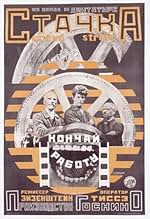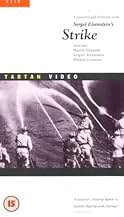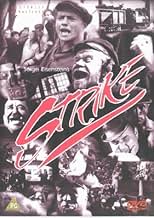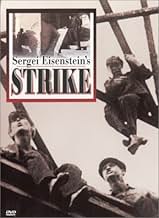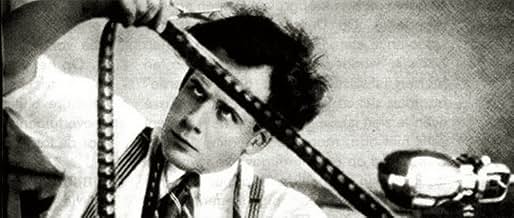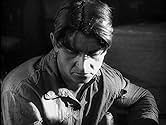NOTE IMDb
7,6/10
8,9 k
MA NOTE
Un groupe d'ouvriers opprimés se met en grève dans la Russie pré-révolutionnaire. La tension monte lorsqu'un travailleur se suicide après avoir été accusé à tort de vol.Un groupe d'ouvriers opprimés se met en grève dans la Russie pré-révolutionnaire. La tension monte lorsqu'un travailleur se suicide après avoir été accusé à tort de vol.Un groupe d'ouvriers opprimés se met en grève dans la Russie pré-révolutionnaire. La tension monte lorsqu'un travailleur se suicide après avoir été accusé à tort de vol.
Leonid Alekseev
- Factory Sleuth
- (non crédité)
Daniil Antonovich
- Worker
- (non crédité)
Pyotr Malek
- Police Spy
- (non crédité)
Misha Mamin
- Baby Boy
- (non crédité)
Pavel Poltoratskiy
- Stockholder
- (non crédité)
Histoire
Le saviez-vous
- AnecdotesStrike (Russian: La grève (1925)) is a Soviet silent propaganda film edited and directed by Sergei Eisenstein. Originating as one entry out of a proposed seven-part series titled "Towards Dictatorship of the Proletariat," Strike was a joint collaboration between the Proletcult Theatre and the film studio Goskino. As Eisenstein's first full-length feature film, it marked his transition from theatre to cinema, and his next film Le cuirassé Potemkine (1925) (Russian: Bronenosets Potyomkin) emerged from the same film cycle.
- GaffesThe story is set in 1903. Throughout the film, automobiles from the 1920s appear on streets. One is the 1920s auto that the worker (who stole the administrators' posted reply to workers' demands) tried to use to escape police goons during a nighttime rainstorm. When upper-class women appear, they are wearing contemporary 1920s fashions, and the popular music that's on the sound track is also from the 1920s.
- Citations
Title Card: At the factory, all is calm. BUT. The boys are restless.
- Versions alternativesThe film was restored at Gorky Film Studio in 1969.
- ConnexionsEdited into Ten Days That Shook the World (1967)
Commentaire à la une
Russian master Sergei Eisenstein's first feature film is a tour-de-force of cinematic technique. He appears to have a pretty speedy learning curve, beginning straight away with a picture that is confidently crafted and extremely watchable even today.
With the exception of Que Viva Mexico (which he made outside Russia), this is Eisenstein's purest film, the one most free from the constraints of the Bolshevik propaganda machine. There is one mention of the Bolsheviks, but it's inconsequential. This is essentially a film about self-organisation of the workers a placeless and timeless story which acts as a case study in how a strike can begin, how it can be made successful and how it can be defeated.
Strike has an incredibly exhilarating pace to it and, aside from its political message works as a pure action film. Perhaps unusually for a debut film, this is also the closest Eisenstein came to making a comedy. In a style that would mark all his films, he characterises the villains of the piece the factory management, police chiefs and government bureaucrats as exaggerated and often ridiculous figures of fun. The factory owner is the stereotypical capitalist a top hat-wearing fat controller.
As usual with early Soviet cinema, Strike is essentially characterless. The story is told through the masses, and the proletariat as a whole is the hero. Eisenstein was ideally suited to this, as even in this early film he gives an unprecedented realism to the crowd scenes, and uses every technique at his disposal to create drama from mass action. Eisenstein also demonstrates early on that he has the rather unusual talent of directing large groups of people being massacred. It's an image that would crop up in nearly all of his films.
The only real weakness of Strike is that it too often slips into pretentiousness. Some of the techniques are little more than showing off. There are just a few too many superimpositions and mirror images shots. The symbolism is also often a little too heavy-handed and abstract the two kids dancing on the table during the interrogation scene certainly baffles me; god knows what the Russian public made of it.
Eisenstein is often described as a pioneer, a founding father of film technique. However, in truth most of the techniques he used had been developed earlier, in particular by D.W. Griffith. It's just that Eisenstein pushed the possibilities of editing to their extreme. He's more of a maverick than a pioneer, as there really has been no-one like him since. Having said that, I can identify three new uses of the editing process that Eisenstein invented with Strike.
Firstly, he often uses a sequence of similar shots to give the impression of the same action being done by lots of people. For example, three shots of tools being thrown to the ground tells us quickly and effectively, in the context of the scene, that the entire workforce is downing tools. Secondly, he edits rhythmically to punctuate action. For example, a quick, dynamic action like someone throwing a punch or a door slamming shut will be punctuated by a film cut, giving it much more impact. This is particularly effective in silent film, as the jarring cuts mean you can almost hear the action in your head.
The third editing technique debuted here was the most abstract and the least influential. Whereas Griffith would edit back and forth between two or more literally related scenes (for example, between someone in trouble and someone coming to rescue them) to build up tension, Eisenstein edits back and forth between unrelated images to create a metaphor. The well-known example of this in Strike is the cutting from the workers being gunned down to shots of cattle being slaughtered the cattle dying is nothing to do with the plot, but it makes a point. It's a clever idea, but one that was rarely imitated as it breaks up the flow of a film's narrative.
On a totally different note, a little hobby of mine is spotting modern day look-alikes in old films, and Strike has one of my favourites. The king of the beggars is a dead ringer for Shane MacGowan, right down to the missing teeth. Amazing.
Strike has to be one of the most remarkable and mould-breaking debut films of all time. It's not quite up to the level of masterpiece yet, but it's an incredible experience and genuinely gripping entertainment.
With the exception of Que Viva Mexico (which he made outside Russia), this is Eisenstein's purest film, the one most free from the constraints of the Bolshevik propaganda machine. There is one mention of the Bolsheviks, but it's inconsequential. This is essentially a film about self-organisation of the workers a placeless and timeless story which acts as a case study in how a strike can begin, how it can be made successful and how it can be defeated.
Strike has an incredibly exhilarating pace to it and, aside from its political message works as a pure action film. Perhaps unusually for a debut film, this is also the closest Eisenstein came to making a comedy. In a style that would mark all his films, he characterises the villains of the piece the factory management, police chiefs and government bureaucrats as exaggerated and often ridiculous figures of fun. The factory owner is the stereotypical capitalist a top hat-wearing fat controller.
As usual with early Soviet cinema, Strike is essentially characterless. The story is told through the masses, and the proletariat as a whole is the hero. Eisenstein was ideally suited to this, as even in this early film he gives an unprecedented realism to the crowd scenes, and uses every technique at his disposal to create drama from mass action. Eisenstein also demonstrates early on that he has the rather unusual talent of directing large groups of people being massacred. It's an image that would crop up in nearly all of his films.
The only real weakness of Strike is that it too often slips into pretentiousness. Some of the techniques are little more than showing off. There are just a few too many superimpositions and mirror images shots. The symbolism is also often a little too heavy-handed and abstract the two kids dancing on the table during the interrogation scene certainly baffles me; god knows what the Russian public made of it.
Eisenstein is often described as a pioneer, a founding father of film technique. However, in truth most of the techniques he used had been developed earlier, in particular by D.W. Griffith. It's just that Eisenstein pushed the possibilities of editing to their extreme. He's more of a maverick than a pioneer, as there really has been no-one like him since. Having said that, I can identify three new uses of the editing process that Eisenstein invented with Strike.
Firstly, he often uses a sequence of similar shots to give the impression of the same action being done by lots of people. For example, three shots of tools being thrown to the ground tells us quickly and effectively, in the context of the scene, that the entire workforce is downing tools. Secondly, he edits rhythmically to punctuate action. For example, a quick, dynamic action like someone throwing a punch or a door slamming shut will be punctuated by a film cut, giving it much more impact. This is particularly effective in silent film, as the jarring cuts mean you can almost hear the action in your head.
The third editing technique debuted here was the most abstract and the least influential. Whereas Griffith would edit back and forth between two or more literally related scenes (for example, between someone in trouble and someone coming to rescue them) to build up tension, Eisenstein edits back and forth between unrelated images to create a metaphor. The well-known example of this in Strike is the cutting from the workers being gunned down to shots of cattle being slaughtered the cattle dying is nothing to do with the plot, but it makes a point. It's a clever idea, but one that was rarely imitated as it breaks up the flow of a film's narrative.
On a totally different note, a little hobby of mine is spotting modern day look-alikes in old films, and Strike has one of my favourites. The king of the beggars is a dead ringer for Shane MacGowan, right down to the missing teeth. Amazing.
Strike has to be one of the most remarkable and mould-breaking debut films of all time. It's not quite up to the level of masterpiece yet, but it's an incredible experience and genuinely gripping entertainment.
Meilleurs choix
Connectez-vous pour évaluer et suivre la liste de favoris afin de recevoir des recommandations personnalisées
- How long is Strike?Alimenté par Alexa
Détails
- Durée1 heure 22 minutes
- Couleur
- Mixage
- Rapport de forme
- 1.33 : 1
Contribuer à cette page
Suggérer une modification ou ajouter du contenu manquant



